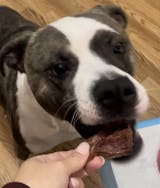We started out with the Chips, Chunks, & Scraps to try, and the kiddos love! I'm impressed by how long even these smaller pieces take them to get through! <3
These are long lasting, extremely satisfying, healthy chews for all the crew, from small to large, they can't get enough! I now have a subscription so we don't run out! The box is packed with care plus a really nice little note of thanks! Awesome company! I would give them ten stars 🤩
My dog is a big chewer and destroys toys and chews easily but she has to work on these. I give them to her for 10-20 mins. She loves them. Have already recommended them to friends and will buy again
This is Gus, the 8 month old Anatolian Shepard and his paci. lol. Seriously the best! It has held up to all the giant puppy chewing and tossing and helps wear him down. He even falls asleep with it in his mouth then wakes up so happy it’s still there. 10/10 will purchase again!
Our 25 pound French bulldog is utterly obsessed with her ugly. Choose! I purchased the medium size and she LOVES them!!! To the point when we ask her to go outside and take a walk, which is her favorite thing, she will go and grab her chew and run around the house excitedly and then sit down and munch on it instead of going to the door. She has to have one of them around at all times, in the middle of the night I kicked it off the bed and she woke up, jumped off the bed to get it, and bring it back to the bed, just to have it next to her 🤣 For the chewing part, five + stars! She is a super aggressive chewer and these babies are going to last! Usually at this point she would’ve completely destroyed or eaten the entire thing but she’s barely made a dent so definitely worth the money. I can’t say enough good things about these choose. absolutely love this company, a customer we will forever be!!
I have 5 border collies and I love these chews, because I can choose an appropriate size for each one. The older dogs prefer smaller/thinner and the young ones like the larger ones.
I'm always on the lookout for different chews for my 1 year old 60 lb pit and I've had my eye on these for a while. I got a pack of the large rolls and and they were an instant hit! I give her yak cheese, antlers, collagen chews, and bully sticks on rotation and other than the bully sticks she usually carries the chew around for a while before she settles to eat it but as soon as I handed it to her she started chewing right away so I think that's a resounding endorsement! I did read the instructions about only letting her chew for 20 minutes and letting it harden back up again which is what I do for her collagen rolls and they will last her a couple of sessions. Considering 20 minutes is how long a regular bully stick lasts with her and she'll eat it all, I don't mind doing a little extra work for something that will last me a few more times.
My pup LOVES her bones! She is a huge fan of the fur on these. She's always hiding it for later 😅
Ok so first-- yes they're ugly but after your dog chews on the ends, they won't look any different than any other rawhide. There's no smell whatsoever, even after they've been chewed. There are four dogs in the house and all of them loved them. The Yorkie claimed all the scraps and did her worst with what teeth she has left. Another has a sick tummy all the time and the roughage on the chews worked better than the fiber supplements I've been giving him. We'll definitely re-purchase soon.
I have 2 GSPs(high energy, can’t stop won’t stop) and the only thing I’ve found that lasts them more than 20 minutes is a hard to find ostrich bone, then one day they decided to say “challenge accepted” and beat that record lol. First day I opened the box for the Hair on Hide rolls they sniffed and sniffed and then fought over them! I took them away after 30 mins since they have sensitive tummies and my youngest was halfway done. Took them out the next day and even if my youngest is the only one that LOVES them every time it’s worth it!! I appreciate Uglychews for the zero waste, natural content, and the time it takes for my INSANELY aggressive chewers to gnaw on these! Keep in mind I work and train with my babies multiple times a day (short increments) so a pup that doesn’t get a lot of exercise/attention/enrichment might go through them a bit faster. But my pups could be the poster children for our local natural petstore and they actually look to me for recommendations 🤣
My pup loves the hide rolls for a longer-lasting enrichment chew so I wanted to give the chips a try. She absolutely goes crazy for the chips and they make a perfect snack sized treat for special occasions. I love supporting family-owned businesses and when a shipping problem occurred with my order they were so kind and helpful in getting my package to me. This is one of my favorite shops and I highly recommend giving them a try!
This was our first time ordering from Ugly Chews and my dogs loved it! They were so excited when I opened the box and let them smell it. We will definitely be repurchasing!
My 4 dogs just loved them! I also liked that these treats didn’t smell bad at all. I would definitely recommend them! I look forward to trying other products too!
So far he’s gotten 3 30 minute sessions with this. The only caution I’d give is if your dog is very pry driven like mine you need to make sure you trade out when you need to take it away. He’s very possessive of these.
My dog could not WAIT to get into these. She can be a little selective with fur-on treats but she took to these instantly. Definitely will be ordering more
Our little guy went to town on these chews. True to their name they are VERY ugly, but according to the dog it only makes them taste better.
My pitty and little mutt loved the chews. My only complaint is the tufts of hair around the house and my pit hacked up a hairball like a cat. Hahaha. That’s the only reason I gave them 4 stars.
My German Shepherd/Pitbull mix absolutely destroyed half a chew in about 10 minutes. The rolls also look much thinner than the advertised photos show, even though I ordered the largest size. He sure loved them but for the price I was very disappointed he was able to get through it so fast.
I have an older dog that's picky about treats. He sniffed his first Ugly Chew for a few seconds, then started chewing. He really enjoyed it, and had no stomach issues. I highly recommend these!
The Good:My dog enjoyed these! There was no smell and no upset tummy.
The Bad: They didn't last long. My dog finished one in about an hour.
The Ugly: They definitely live up to their name. Pretty shocking when I first opened the package.
My dogs (5 of the 6!) LOVE ugly chews. They don't smell at all. All my friends ask if they smell, NOPE. Bully sticks smell so much but these smell like nothing. How nice is it to use the bits of the cow that would traditionally just be trash. I highly recommend these.
My dogs absolutely loved these. They took them everywhere with them and really enjoyed them. I was surprised. Usually they end up just leaving half eaten treats all over. These, they guarded with their lives like they were their personal teddy bears. I'm impressed!
Indeed he did! Max loves his ugly chews. Expensive but worth it. No stomach issues afterwards which is a much needed surprise. Lasted about 5ish hours under optimal conditions which is a compliment coming from a Black Mouth Cur.





















































